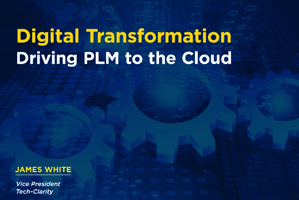 How can manufacturers adopt cloud PLM to support digital transformation but avoid being stuck with a dead-end, custom system? Is it time to force a hard decision between customization and the cloud? Read Digital Transformation Driving PLM to the Cloud to learn what three leading manufacturers and our research have to say.
How can manufacturers adopt cloud PLM to support digital transformation but avoid being stuck with a dead-end, custom system? Is it time to force a hard decision between customization and the cloud? Read Digital Transformation Driving PLM to the Cloud to learn what three leading manufacturers and our research have to say.
- How today’s manufacturers are leveraging cloud PLM to support their digital transformation initiatives
- The business triggers that lead to upgrading current PLM solutions
- The compelling benefits of cloud and architecture choices that need to be made
- How low-code PLM can support digital transformation
The eBook shares deep insights from recent research that highlights PLM’s new, elevated role in digital transformation and how cloud PLM leveraging a low-code architecture can help them achieve their goals.
For related research, watch the How Digital Transformation Is Driving PLM to the Cloud webcast.
Please enjoy the summary* below. Please visit our sponsor, Aras, for the full research (registration required).
Table of Contents
- Executive Summary
- The Manufacturer’s Viewpoint on PLM
- The Need to Upgrade PLM
- Cloud is Compelling
- Evaluating PLM Deployment Options
- Out-of-the-Box (OOTB) is a Fallacy
- Functionality First
- Cloud and Custom Aren’t Incompatible
- Key Takeaways
- Acknowledgments
Executive Summary
Digital Transformation Demands New Capabilities, Agility
Digital transformation is intensifying the need to tailor PLM systems to serve as a company’s digital backbone and support new ways of innovating and operating. Engineers need the latest features and capabilities, but also need to keep the “right-for-me” PLM capabilities they already have. PLM solutions that are customized to achieve these goals, however, can create an ongoing need for specialized services that can limit agility and prevent adoption of new features and software versions.
Transitioning to the Cloud
Cloud solutions are compelling but are not commonly as tailorable as traditional solutions to provide a customized experience. Cloud offers numerous business and technical advantages including lower costs, less need for IT support, strong security, high availability, and practically infinite scalability. The tradeoff is typically a more out-of-the-box (OOTB) solution with lower ability to customize to enforce company standards and provide the right experience to the end user.
“Cloud” and “Customization” can Co-Exist
Our experience shows that most PLM implementations are not OOTB, especially for large organizations. This creates tension between cloud benefits and creating the new digital backbone and a “right-for-me” experience. As our experience and the research for this eBook shows, however, the right balance between cloud benefits and desired customization may be available through the emerging alternative to customization, low-code / no-code development.
Evaluating PLM Deployment Options
Cloud Comes in a Variety of Options
Cloud is compelling, but “the cloud” is not a single option. There are multiple ways to implement PLM. Let’s look at the impacts of the different options on factors like cost, agility, and the ability to customize for the “right for me” experience. Note that these are generalizations and we recognize that there are exceptions to every rule.
Key Takeaways
 Research for this report leads our analysts to the following conclusions:
Research for this report leads our analysts to the following conclusions:
- PLM is becoming the digital backbone for manufacturers’ digital transformation strategy
- Most engineers prioritize PLM functionality and the “right-for-me” experience over cloud benefits. Traditional customization approaches lead to large technical debt and can result in dead-end customizations.
- PLM is a business imperative, and like the business, it’s a moving target. It’s important to have the ability to adapt the PLM system as needs change, to remain agile, without adding technical debt.
- Cloud and customization can both be options at the same time. The right PLM architecture can provide cloud benefits while also enabling customization without incurring significant technical debt.
It’s important to step back, assess current and future needs, then decide which architecture(s) best supports the business.
*This summary is an abbreviated version of the research and does not contain the full content. Please visit our sponsor Aras for the full research (registration required).
If you have difficulty obtaining a copy of the report, please contact us.


